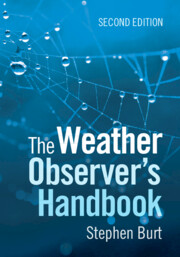Book contents
- The Weather Observer’s Handbook
- Reviews
- The Weather Observer’s Handbook
- Copyright page
- Dedication
- Epigraph
- Contents
- Foreword
- Acknowledgements
- Author’s note
- Abbreviations, footnotes and references
- Part I The basics
- Part II Measuring the weather
- 4 Site and exposure: The basics
- 5 Measuring the temperature of the air
- 6 Measuring precipitation
- 7 Measuring atmospheric pressure
- 8 Measuring humidity
- 9 Measuring wind speed and direction
- 10 Measuring grass and earth temperatures
- 11 Measuring sunshine and solar radiation
- 12 Observing hours and time standards
- 13 AWS data flows, display and storage
- 14 Non-instrumental weather observing
- 15 Calibration
- 16 Metadata: What is it, and why is it important?
- Part III Making the most of your observations
- Book part
- References and Further Reading
- Index
9 - Measuring wind speed and direction
from Part II - Measuring the weather
Published online by Cambridge University Press: 21 May 2024
- The Weather Observer’s Handbook
- Reviews
- The Weather Observer’s Handbook
- Copyright page
- Dedication
- Epigraph
- Contents
- Foreword
- Acknowledgements
- Author’s note
- Abbreviations, footnotes and references
- Part I The basics
- Part II Measuring the weather
- 4 Site and exposure: The basics
- 5 Measuring the temperature of the air
- 6 Measuring precipitation
- 7 Measuring atmospheric pressure
- 8 Measuring humidity
- 9 Measuring wind speed and direction
- 10 Measuring grass and earth temperatures
- 11 Measuring sunshine and solar radiation
- 12 Observing hours and time standards
- 13 AWS data flows, display and storage
- 14 Non-instrumental weather observing
- 15 Calibration
- 16 Metadata: What is it, and why is it important?
- Part III Making the most of your observations
- Book part
- References and Further Reading
- Index
Summary
In order to provide representative measurements of wind speed and direction, measuring devices must be deployed in suitable locations or sites and the instruments themselves exposed to the wind they are intended to measure in a standardised manner. This chapter sets out what those standardised conditions of site and exposure are for measurements of wind speed and direction, including the treatment of wind gusts and construction of the vector mean wind, following the guidelines laid down by the World Meteorological Organization in the so-called CIMO guide (Commission for Instruments and Methods of Observation). Well-exposed sites can be difficult to find, and optimal exposure conditions for wind instruments differ considerably from most other meteorological instruments. Instruments to measure both wind speed (cup and sonic anemometers) and wind direction (wind vanes and sonic anemometers) are covered, with their limitations, together with a description of the Beaufort wind scale, which is useful if suitable instruments (or a suitable site for them) are not available.
Keywords
- Type
- Chapter
- Information
- The Weather Observer's Handbook , pp. 217 - 250Publisher: Cambridge University PressPrint publication year: 2024

